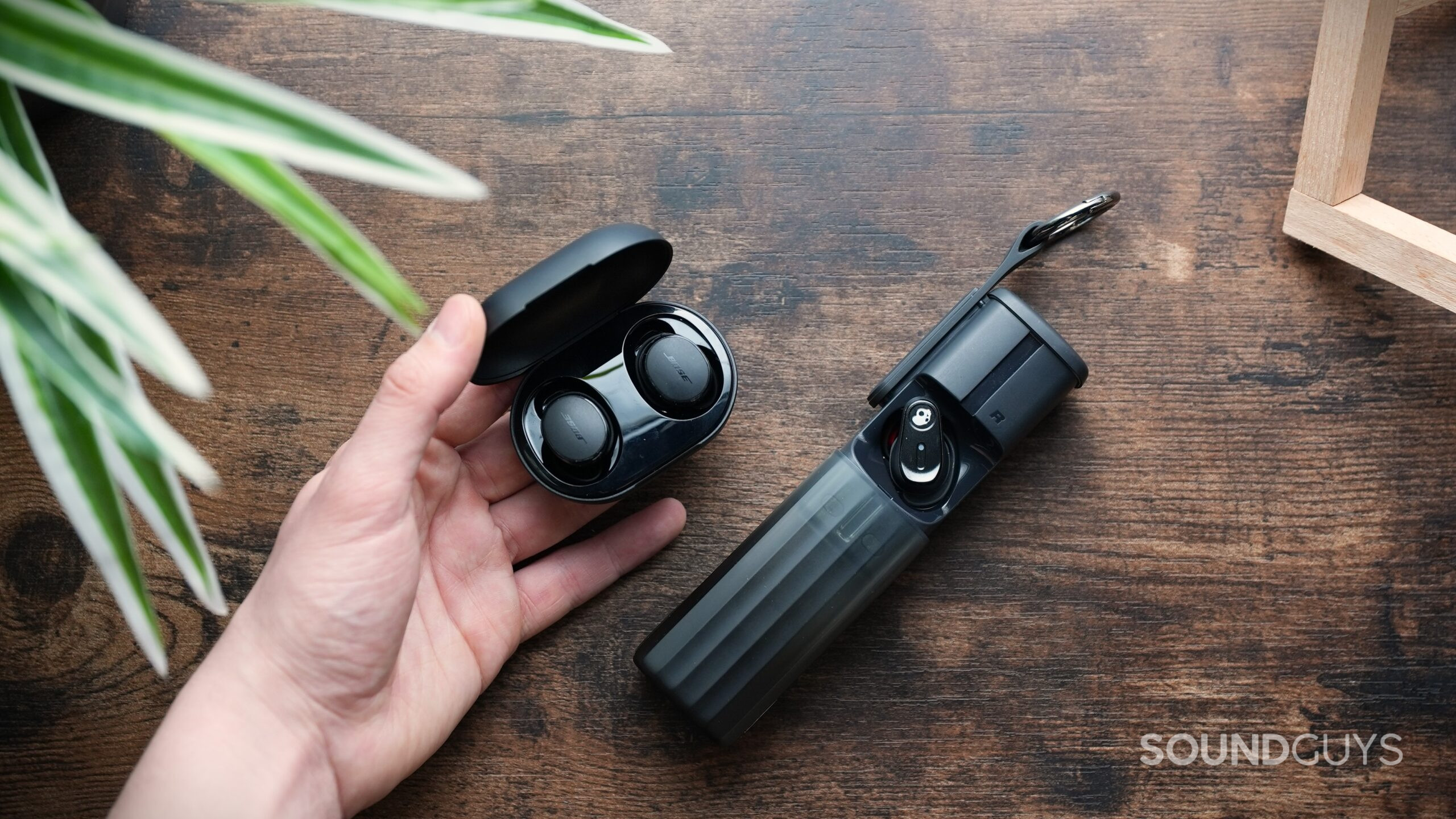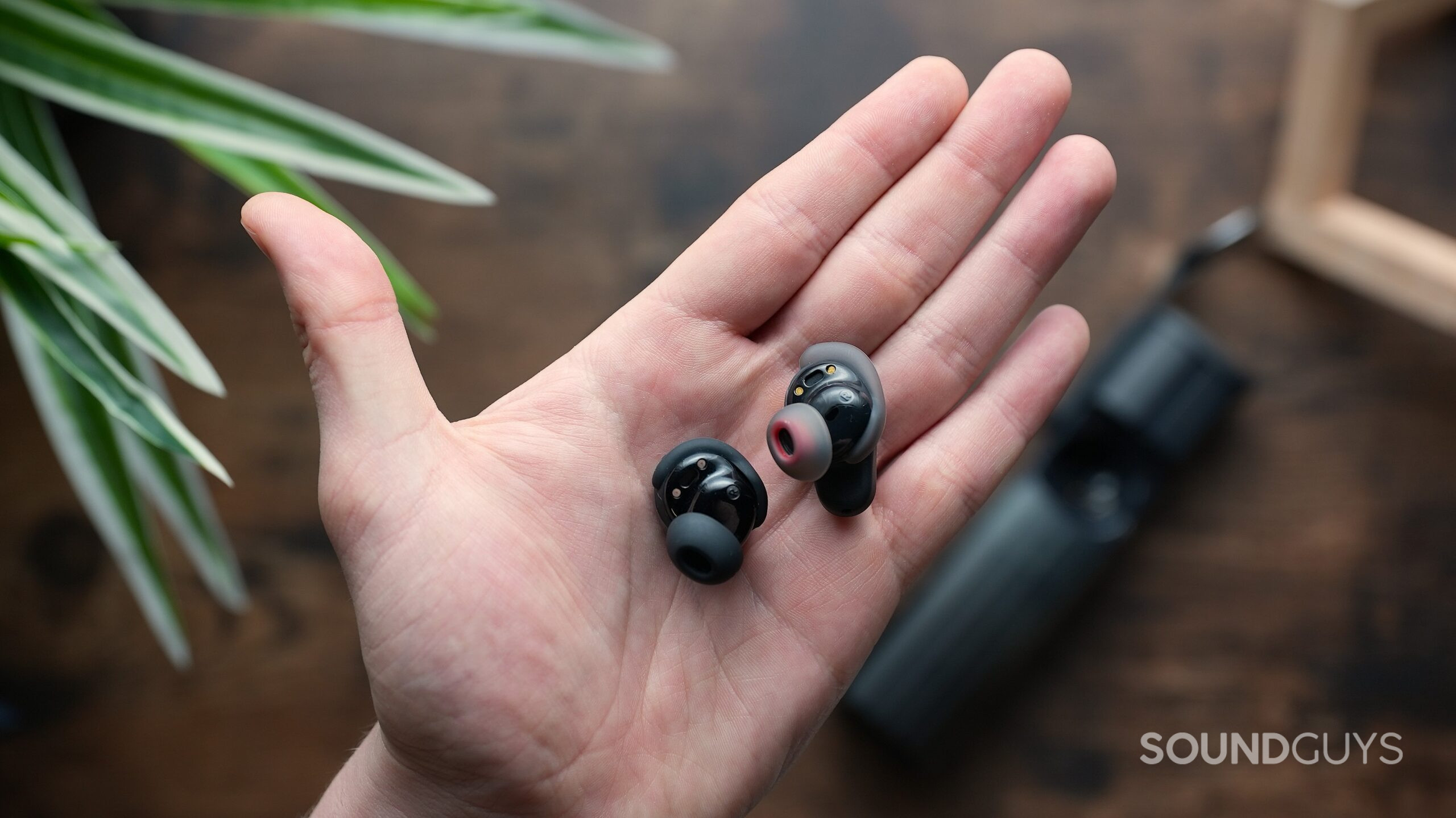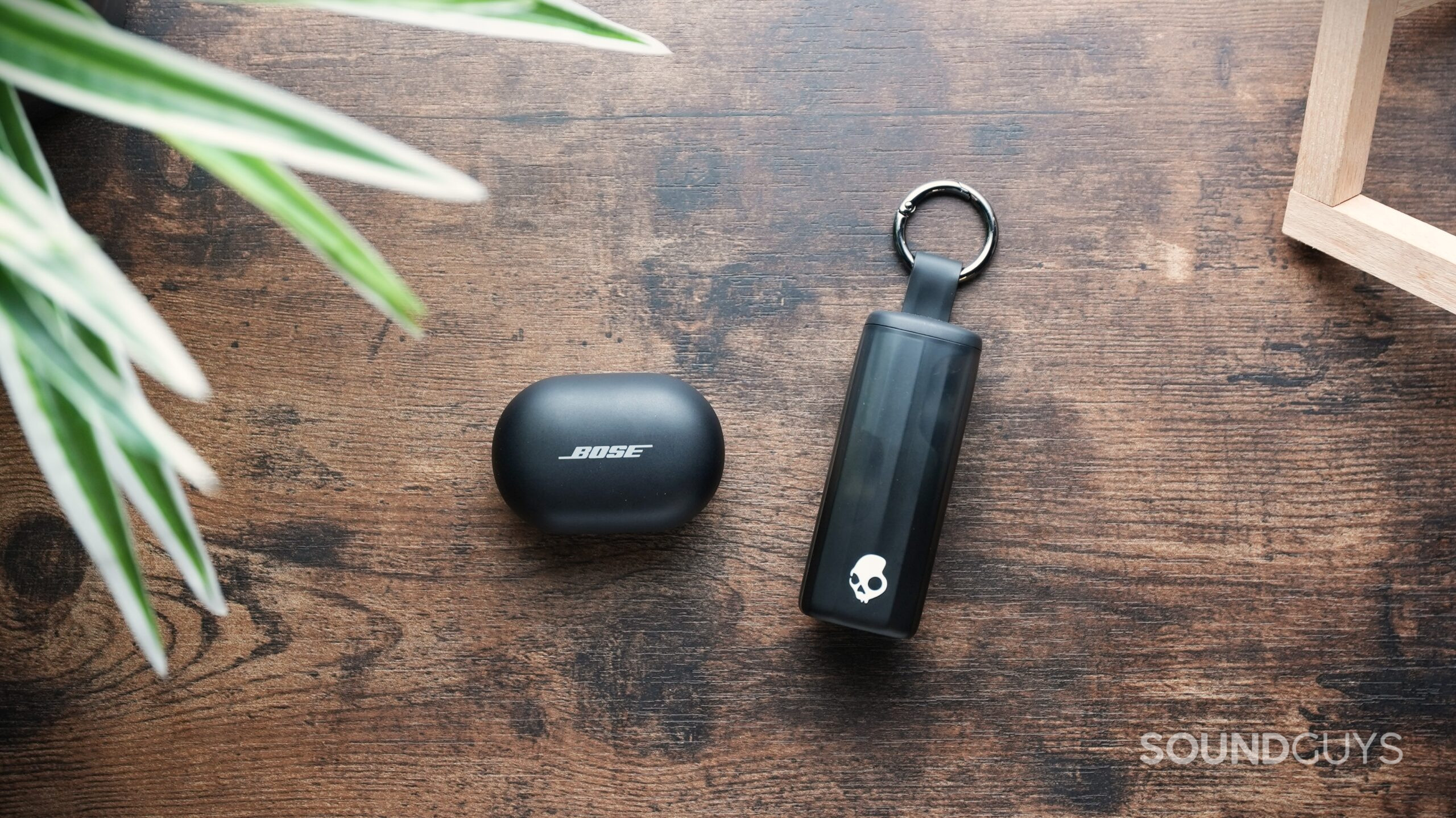All products featured are independently chosen by us. However, SoundGuys may receive a commission on orders placed through its retail links. See our ethics statement.
Skullcandy Method 360 ANC vs Bose QuietComfort Earbuds: The student becomes the master
May 6, 2025




We all expected Bose to continue refreshing its premium earbud lineup. But Skullcandy partnering with Bose to create a budget-friendly alternative? Well, no one saw that coming. These wireless earbuds both promise premium sound quality and effective noise cancelation, but with a $50-80 price difference between them, which is the better bang for your buck? Let’s look at how these earbuds stack up against each other.
This article was initially published on May 6, 2025, and this is the first version.
What’s it like to use the Skullcandy Method 360 ANC compared to the Bose QuietComfort Earbuds?

The Skullcandy Method 360 ANC earbuds might give you déjà vu — they’re practically identical in shape and size to Bose’s QuietComfort Ultra Earbuds, the next step up from Bose’s earbuds being looked at in this article. Bose essentially provides the skeleton of Method 360 ANC: the drivers, acoustic tuning, and licensed ear tips and fins from the QC Ultra. Skullcandy adds the skin, wrapping that foundation in lightweight, cheaper plastic and offering a range of bold color options.
The Bose QuietComfort Earbuds have a more compact design, resting within your ears rather than having a protruding stem. However, they’re still bulkier than many competitors, which might cause discomfort for those with smaller ears. Overall, the Method 306 ANC fit is more secure and stable as it borrows from Bose’s premium earbud design. The charging case here is also massive and made from similarly cheap plastic.
The Method 360 ANC’s case is also very large and not the most pocketable. Instead, it has an integrated carabiner clip to hang from a backpack or belt loop. Each earbud slots into opposite sides of the case, so when it’s clipped and facing away from you, the right earbud is on your right and the left on your left. This unique design choice makes it less intuitive when not wearing the case, and the sliding mechanism can loosen over time with rough usage.
| Input | Either Earbud |
|---|---|
Single Tap | Play/Pause Anwser Call |
Double Tap | Track Forward |
Triple Tap | ANC On Stay-Aware Mode On ANC Off |
1 Second Hold | End Call Reject Incoming Call Spotify Tap |
| Input | Left earbud | Right earbud |
|---|---|---|
| Input Single tap | Left earbud Play/pause, answer call | Right earbud Play/pause, answer call |
| Input Double tap | Left earbud Skip, end call | Right earbud Skip, end call |
| Input Triple tap | Left earbud Previous track | Right earbud Previous track |
| Input Tap and hold | Left earbud Decrease volume | Right earbud Increase volume |
Do the Skullcandy Method 360 ANC or Bose QuietComfort Earbuds have more features?
Both earbuds come with companion apps that offer similar, if not identical, capabilities. That’s because the Skullcandy IQ app is essentially the same app that the Bose QuietComfort earbuds use, just reskinned.
The Bose QC Earbuds app features a five-band equalizer, an improvement on the three-band equalizer in the older Bose app. Similarly, the Skullcandy app offers three EQ presets out of the box, plus a customizable five-band equalizer.
Both apps allow adjusting noise cancelation intensity, but the Skullcandy earbuds add some unique features like low-latency Studio Mode for gamers, button remapping, and shortcuts like Spotify Tap or triggering your phone’s camera shutter.
The Bose app includes a Battery Prediction feature that estimates how much listening and talk time you have left. However, there’s no find my functionality, so make sure you don’t lose your earbuds.
The Skullcandy earbuds have one annoying issue: the built-in voice prompts are uncomfortably loud, regardless of your device’s volume settings, with currently no way to adjust the volume or disable them.
How do the Skullcandy Method 360 ANC and Bose QuietComfort Earbuds connect?
Both earbuds connect to devices via Bluetooth 5.3 with codec support limited to AAC and SBC. You don’t get any advanced Bluetooth codecs like aptX or LDAC, but you do get Bluetooth Multipoint to connect to multiple devices simultaneously.
During testing, we experienced connectivity problems with both earbuds. Often, one earbud, particularly the left earbud, would inexplicably drop out or unsync from the other. This issue appeared while switching between EQ presets and connecting to new or multiple devices. However, we were able to fix it after several factory resets.
Is battery life better on the Skullcandy Method 360 ANC or the Bose QuietComfort Earbuds?

The Bose QuietComfort Earbuds are rated to last 8.5 hours on a single charge. The charging case holds 2.5 additional charges for up to 31.5 hours of total playback time.
In testing, the Method 360 ANC managed 7 hours and 43 minutes with ANC on — a respectable result that comes close to the advertised 9 hours. With the case, you’ll get a total of 32 hours before needing to recharge. Switching ANC off extends battery life to around 11 hours in the earbuds and up to 40 hours total with the case.
The Skullcandy’s Rapid Charge feature gives you about 2 hours of playback from just 10 minutes plugged in. Neither earbud supports wireless charging.
Do the Skullcandy Method 360 ANC or Bose QuietComfort Earbuds block noise better?
Loading chart ...
Both earbuds have fairly impressive noise canceling performance, with the Bose QuietComfort doing a bit better job at canceling low-end noise. Overall, our testing shows that the ANC of both earbuds can reduce the perceived loudness of most noises by 80%. The large earbud size, combined with the variety of ear tips and fins, helps to isolate against a significant amount of high-frequency noise.
Both earbuds offer transparency modes, with Bose calling theirs “Aware Mode” and Skullcandy referring to it as “Stay-Aware Mode.”
Do the Skullcandy Method 360 ANC sound better than the Bose QuietComfort Earbuds?
The Bose QuietComfort Earbuds deliver a more balanced sound with good clarity and detail across genres, while the Skullcandy Method 360 ANC offers a much bassier, more V-shaped sound signature that can be enjoyable for bass-heavy genres but tends to make vocals sound dull and recessed in comparison. Thankfully, both earbuds have a 5-band custom EQ to tweak the sound signature.
Multi-Dimensional Audio Quality Scores (MDAQS)
Both earbuds received nearly identical Multi-Dimensional Audio Quality Score (MDAQS) overall ratings of 4.9 out of 5, suggesting that most listeners would find both enjoyable right out of the box.
Despite the identical overall scores, the Bose earbuds score significantly better in the Distortion category (4.1 vs 3.1), indicating cleaner sound reproduction. Both have excellent scores for Timbre and Immersiveness.
- Timbre (MOS-T) represents how faithfully the headphones reproduce the frequency spectrum and temporal resolution (timing information).
- Distortion (MOS-D) represents non-linearities and added noise: higher scores mean cleaner reproduction.
- Immersiveness (MOS-I) represents perceived source width and positioning: how well virtual sound sources are defined in three-dimensional space.
Objective Measurements
Loading chart ...
The frequency response chart above illustrates clear differences between these earbuds. Both have some big deviations from our house curve, but the Skullcandy Method 360 ANC (blue line) shows dramatically higher sub-bass output, reaching nearly 20dB above the reference curve compared to Bose’s more moderate 12dB boost. Both follow a U-shaped signature with recessed mids, but Skullcandy takes this to an extreme. The treble region shows both earbuds with peaks around 3-4kHz, adding brightness that can become harsh at higher volumes, with Skullcandy again pushing this further. Overall, Bose offers a more balanced but still bass-forward sound, while Skullcandy delivers an extremely V-shaped signature with a bass emphasis that can be overwhelming.
Do the Skullcandy Method 360 ANC or Bose QuietComfort Earbuds have a better microphone?
The microphones on the Bose QuietComfort Earbuds work well for taking calls on the go. If you are in a very noisy environment, the person on the other end of the line might have some trouble hearing you, but the microphones are usable in most environments.
The Skullcandy Method 360 ANC’s microphone delivers a clear but noticeably processed voice quality. Speech comes through intelligibly and with decent clarity, but it sounds thin and slightly recessed, lacking the fullness and warmth you’d get from something like a dedicated headset mic or higher-end earbuds.
Skullcandy Method 360 ANC microphone demo (Ideal conditions):
Bose QuietComfort Earbuds microphone demo (Ideal conditions):
Skullcandy Method 360 ANC microphone demo (Street conditions):
Bose QuietComfort Earbuds microphone demo (Street conditions):
Skullcandy Method 360 ANC vs Bose QuietComfort Earbuds: Price and availability
The Bose QuietComfort Earbuds (2024) are priced at $179 at Amazon, while the Skullcandy Method 360 ANC launched at a promotional price of $99.99 at Amazon but has an official MSRP of $129.99.
Both earbuds are available for purchase on their respective manufacturers’ websites and through major retailers like Amazon.
Should you get the Skullcandy Method 360 ANC or the Bose QuietComfort Earbuds?

Overall, the Skullcandy Method 360 ANC delivers just-as-good ANC and many of the same features as Bose earbuds for a lower price, but with a more bass-heavy sound and some design quirks.
Choose the Skullcandy Method 360 ANC if:
- You like to feel the bass
- You would use the carabiner case for attaching to bags or belts
Choose the Bose QuietComfort Earbuds if:
- You prefer a more balanced sound signature
- You value a traditional charging case design
Both earbuds deliver good sound quality for their respective price points, even if neither perfectly matches our house curve. However, we have concerns about dropped connections with both earbuds, and the quirky case design of the Method 360 ANC might be a dealbreaker for some. Still, for under $100, Skullcandy and Bose’s collaboration here makes the best case for the best bang for your buck.


Noise canceling
App with 5-band custom EQ
What should you get instead?
If you want more balanced sound quality, consider the Creative Aurvana Ace 2 ($149.99 at Amazon). Owing to their xMEMS silicon drivers, the Aurvana Ace 2 sounds better than most earbuds on the market. You also get active noise canceling and support for aptX Lossless.
If you want more features and customization options, consider the new Nothing Ear ($179 at Amazon). The Nothing Ear have an advanced equalizer that lets you tweak the sound quality to your exact liking. You also get noise canceling, high-res codecs, and great battery life with these earbuds.
For something more affordable with great sound quality, LDAC support, and an app packed with plenty of customization, the Anker Soundcore Liberty 4 Pro ($129.99 at Amazon) is an excellent buy.
Thank you for being part of our community. Read our Comment Policy before posting.